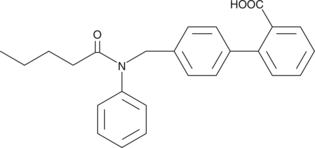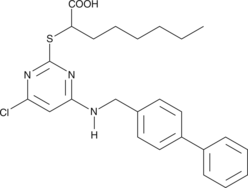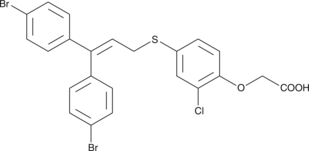Cayman
Showing 13951–14100 of 45550 results
-
Leukotriene B4 (LTB4) promotes a number of leukocyte functions including aggregation, stimulation of ion fluxes, superoxide anion production, chemotaxis, and chemokinesis. Two G protein-coupled receptors, BLT1 and BLT2 mediate the actions of LTB4. CAY10583 is a potent, selective full agonist for BLT2 with an EC50 value of 20 nM.{15624} It does not displace [3H]-leukotriene B4 (LTB4) binding to BLT1 at concentrations >1 µM and activates BLT2 at significantly lower concentrations than LTB4 (EC50 = 170 nM).{15624} CAY10583 dose dependently increases intracellular calcium stores and induces ERK phosphorylation in Chinese hamster ovary (CHO) cells expressing BLT2 with no effect on CHO cells expressing BLT1.{15624}
Brand:CaymanSKU:10012424 - 25 mgAvailable on backorder
Leukotriene B4 (LTB4) promotes a number of leukocyte functions including aggregation, stimulation of ion fluxes, superoxide anion production, chemotaxis, and chemokinesis. Two G protein-coupled receptors, BLT1 and BLT2 mediate the actions of LTB4. CAY10583 is a potent, selective full agonist for BLT2 with an EC50 value of 20 nM.{15624} It does not displace [3H]-leukotriene B4 (LTB4) binding to BLT1 at concentrations >1 µM and activates BLT2 at significantly lower concentrations than LTB4 (EC50 = 170 nM).{15624} CAY10583 dose dependently increases intracellular calcium stores and induces ERK phosphorylation in Chinese hamster ovary (CHO) cells expressing BLT2 with no effect on CHO cells expressing BLT1.{15624}
Brand:CaymanSKU:10012424 - 5 mgAvailable on backorder
Leukotriene B4 (LTB4) promotes a number of leukocyte functions including aggregation, stimulation of ion fluxes, superoxide anion production, chemotaxis, and chemokinesis. Two G protein-coupled receptors, BLT1 and BLT2 mediate the actions of LTB4. CAY10583 is a potent, selective full agonist for BLT2 with an EC50 value of 20 nM.{15624} It does not displace [3H]-leukotriene B4 (LTB4) binding to BLT1 at concentrations >1 µM and activates BLT2 at significantly lower concentrations than LTB4 (EC50 = 170 nM).{15624} CAY10583 dose dependently increases intracellular calcium stores and induces ERK phosphorylation in Chinese hamster ovary (CHO) cells expressing BLT2 with no effect on CHO cells expressing BLT1.{15624}
Brand:CaymanSKU:10012424 - 50 mgAvailable on backorder
Hypoxia-inducible factor-1 (HIF-1) is a heterodimeric transcription factor composed of a HIF-1α subunit and HIF-1β subunit. Whereas the HIF-1β subunit is constitutively expressed, the HIF-1α subunit is regulated by cellular oxygen levels and therefore plays an important role in maintaining cellular oxygen homeostasis.{11044,12428} Under normoxic conditions, HIF-1α is selectively hydroxylated on proline residues 402 and 577 and targeted for destruction by the ubiquitin-proteasome system. Under hypoxic conditions, HIF-1α accumulates and dimerizes with HIF-1β to promote the transcription of a number of genes involved in angiogenesis, glycolysis, growth factor signaling, tumor invasion, and metastasis. CAY10585 is a novel small molecule inhibitor of HIF-1α accumulation and gene transcriptional activity.{16441} In a gene reporter assay using human Hep3B and AGS cell lines, CAY10585 prevented HIF-1 transcriptional activity with IC50 values of 2.6 and 0.7 µM, respectively. It blocks HIF-1α accumulation in Hep3B cells in a concentration and time-dependent manner, with complete inhibition at a concentration of 30 µM within 12 hours. CAY10585 also significantly suppresses transcription of the HIF-1 target genes VEGF and erythropoietin at 10 µM.{16441}
Brand:CaymanSKU:10012682 - 1 mgAvailable on backorder
Hypoxia-inducible factor-1 (HIF-1) is a heterodimeric transcription factor composed of a HIF-1α subunit and HIF-1β subunit. Whereas the HIF-1β subunit is constitutively expressed, the HIF-1α subunit is regulated by cellular oxygen levels and therefore plays an important role in maintaining cellular oxygen homeostasis.{11044,12428} Under normoxic conditions, HIF-1α is selectively hydroxylated on proline residues 402 and 577 and targeted for destruction by the ubiquitin-proteasome system. Under hypoxic conditions, HIF-1α accumulates and dimerizes with HIF-1β to promote the transcription of a number of genes involved in angiogenesis, glycolysis, growth factor signaling, tumor invasion, and metastasis. CAY10585 is a novel small molecule inhibitor of HIF-1α accumulation and gene transcriptional activity.{16441} In a gene reporter assay using human Hep3B and AGS cell lines, CAY10585 prevented HIF-1 transcriptional activity with IC50 values of 2.6 and 0.7 µM, respectively. It blocks HIF-1α accumulation in Hep3B cells in a concentration and time-dependent manner, with complete inhibition at a concentration of 30 µM within 12 hours. CAY10585 also significantly suppresses transcription of the HIF-1 target genes VEGF and erythropoietin at 10 µM.{16441}
Brand:CaymanSKU:10012682 - 10 mgAvailable on backorder
Hypoxia-inducible factor-1 (HIF-1) is a heterodimeric transcription factor composed of a HIF-1α subunit and HIF-1β subunit. Whereas the HIF-1β subunit is constitutively expressed, the HIF-1α subunit is regulated by cellular oxygen levels and therefore plays an important role in maintaining cellular oxygen homeostasis.{11044,12428} Under normoxic conditions, HIF-1α is selectively hydroxylated on proline residues 402 and 577 and targeted for destruction by the ubiquitin-proteasome system. Under hypoxic conditions, HIF-1α accumulates and dimerizes with HIF-1β to promote the transcription of a number of genes involved in angiogenesis, glycolysis, growth factor signaling, tumor invasion, and metastasis. CAY10585 is a novel small molecule inhibitor of HIF-1α accumulation and gene transcriptional activity.{16441} In a gene reporter assay using human Hep3B and AGS cell lines, CAY10585 prevented HIF-1 transcriptional activity with IC50 values of 2.6 and 0.7 µM, respectively. It blocks HIF-1α accumulation in Hep3B cells in a concentration and time-dependent manner, with complete inhibition at a concentration of 30 µM within 12 hours. CAY10585 also significantly suppresses transcription of the HIF-1 target genes VEGF and erythropoietin at 10 µM.{16441}
Brand:CaymanSKU:10012682 - 25 mgAvailable on backorder
Hypoxia-inducible factor-1 (HIF-1) is a heterodimeric transcription factor composed of a HIF-1α subunit and HIF-1β subunit. Whereas the HIF-1β subunit is constitutively expressed, the HIF-1α subunit is regulated by cellular oxygen levels and therefore plays an important role in maintaining cellular oxygen homeostasis.{11044,12428} Under normoxic conditions, HIF-1α is selectively hydroxylated on proline residues 402 and 577 and targeted for destruction by the ubiquitin-proteasome system. Under hypoxic conditions, HIF-1α accumulates and dimerizes with HIF-1β to promote the transcription of a number of genes involved in angiogenesis, glycolysis, growth factor signaling, tumor invasion, and metastasis. CAY10585 is a novel small molecule inhibitor of HIF-1α accumulation and gene transcriptional activity.{16441} In a gene reporter assay using human Hep3B and AGS cell lines, CAY10585 prevented HIF-1 transcriptional activity with IC50 values of 2.6 and 0.7 µM, respectively. It blocks HIF-1α accumulation in Hep3B cells in a concentration and time-dependent manner, with complete inhibition at a concentration of 30 µM within 12 hours. CAY10585 also significantly suppresses transcription of the HIF-1 target genes VEGF and erythropoietin at 10 µM.{16441}
Brand:CaymanSKU:10012682 - 5 mgAvailable on backorder
The free fatty acid receptor 1 (FFAR1; GPR40) is highly expressed in pancreatic β-cells and activated by medium and long-chain fatty acids.{13138} There is evidence of a link between FFAR1 (GPR40) and the ability of fatty acids to amplify glucose-stimulated insulin secretion, making this signaling pathway a potential target for regulating diabetes, obesity, and other metabolic disorders.{13139,14742} CAY10587 is a selective FFAR1 (GPR40) agonist (EC50 = 32 nM) that does not exhibit activity on the related FFARs: FFAR2 (GPR43) or FFAR3 (GPR41).{16584} At 100 nM, CAY10587 increases glucose-stimulated insulin secretion in the rat insulin-secreting cell line INS-1E.{16584}
Brand:CaymanSKU:-The free fatty acid receptor 1 (FFAR1; GPR40) is highly expressed in pancreatic β-cells and activated by medium and long-chain fatty acids.{13138} There is evidence of a link between FFAR1 (GPR40) and the ability of fatty acids to amplify glucose-stimulated insulin secretion, making this signaling pathway a potential target for regulating diabetes, obesity, and other metabolic disorders.{13139,14742} CAY10587 is a selective FFAR1 (GPR40) agonist (EC50 = 32 nM) that does not exhibit activity on the related FFARs: FFAR2 (GPR43) or FFAR3 (GPR41).{16584} At 100 nM, CAY10587 increases glucose-stimulated insulin secretion in the rat insulin-secreting cell line INS-1E.{16584}
Brand:CaymanSKU:-The free fatty acid receptor 1 (FFAR1; GPR40) is highly expressed in pancreatic β-cells and activated by medium and long-chain fatty acids.{13138} There is evidence of a link between FFAR1 (GPR40) and the ability of fatty acids to amplify glucose-stimulated insulin secretion, making this signaling pathway a potential target for regulating diabetes, obesity, and other metabolic disorders.{13139,14742} CAY10587 is a selective FFAR1 (GPR40) agonist (EC50 = 32 nM) that does not exhibit activity on the related FFARs: FFAR2 (GPR43) or FFAR3 (GPR41).{16584} At 100 nM, CAY10587 increases glucose-stimulated insulin secretion in the rat insulin-secreting cell line INS-1E.{16584}
Brand:CaymanSKU:-The free fatty acid receptor 1 (FFAR1; GPR40) is highly expressed in pancreatic β-cells and activated by medium and long-chain fatty acids.{13138} There is evidence of a link between FFAR1 (GPR40) and the ability of fatty acids to amplify glucose-stimulated insulin secretion, making this signaling pathway a potential target for regulating diabetes, obesity, and other metabolic disorders.{13139,14742} CAY10587 is a selective FFAR1 (GPR40) agonist (EC50 = 32 nM) that does not exhibit activity on the related FFARs: FFAR2 (GPR43) or FFAR3 (GPR41).{16584} At 100 nM, CAY10587 increases glucose-stimulated insulin secretion in the rat insulin-secreting cell line INS-1E.{16584}
Brand:CaymanSKU:-Microsomal Prostaglandin E2 Synthase-1 (mPGES-1), with cyclooxygenase-2 (COX-2), synthesizes PGE2, which is directly involved in signaling during inflammation, fever and pain. 5-Lipoxygenase (5-LO) initiates the synthesis of leukotrienes (LTs), which are pro-inflammatory mediators. CAY10589 is a dual inhibitor of mPGES-1 (IC50 = 1.3 μM) and 5-LO (IC50 = 1.0 μM).{16667} It effectively inhibits PGE2 and LT synthesis in both cell free and intact cell assays. CAY10589 has minor effects on COX-1 and COX-2, inhibiting these enzymes 34% and 38.8%, respectively, at 10 μM.{16667}
Brand:CaymanSKU:-Microsomal Prostaglandin E2 Synthase-1 (mPGES-1), with cyclooxygenase-2 (COX-2), synthesizes PGE2, which is directly involved in signaling during inflammation, fever and pain. 5-Lipoxygenase (5-LO) initiates the synthesis of leukotrienes (LTs), which are pro-inflammatory mediators. CAY10589 is a dual inhibitor of mPGES-1 (IC50 = 1.3 μM) and 5-LO (IC50 = 1.0 μM).{16667} It effectively inhibits PGE2 and LT synthesis in both cell free and intact cell assays. CAY10589 has minor effects on COX-1 and COX-2, inhibiting these enzymes 34% and 38.8%, respectively, at 10 μM.{16667}
Brand:CaymanSKU:-Microsomal Prostaglandin E2 Synthase-1 (mPGES-1), with cyclooxygenase-2 (COX-2), synthesizes PGE2, which is directly involved in signaling during inflammation, fever and pain. 5-Lipoxygenase (5-LO) initiates the synthesis of leukotrienes (LTs), which are pro-inflammatory mediators. CAY10589 is a dual inhibitor of mPGES-1 (IC50 = 1.3 μM) and 5-LO (IC50 = 1.0 μM).{16667} It effectively inhibits PGE2 and LT synthesis in both cell free and intact cell assays. CAY10589 has minor effects on COX-1 and COX-2, inhibiting these enzymes 34% and 38.8%, respectively, at 10 μM.{16667}
Brand:CaymanSKU:-Phospholipase A2 (PLA2) catalyzes the hydrolysis of fatty acids at the sn-2 position of glycerophospholipids, liberating arachidonic acid for subsequent eicosanoid synthesis.{2489} Three primary types of PLA2 exist: secretory (sPLA2), calcium-dependent cytosolic (cPLA2), and calcium-independent cytosolic (iPLA2).{1474} Of these three enzymes, cPLA2 is the rate-limiting stimulus for release of arachidonic acid whereas sPLA2 amplifies the action of cPLA2 and regulates phagocytosis and foam cell formation.{14662} CAY10590, a simple amide based on (R)-γ-norleucine, is a potent and selective inhibitor of sPLA2. It exhibits 95% inhibition (XI(50) = 0.003) of sPLA2 at 0.091 mole fraction without affecting the activities of cPLA2 or iPLA2.{16718}
Brand:CaymanSKU:-Phospholipase A2 (PLA2) catalyzes the hydrolysis of fatty acids at the sn-2 position of glycerophospholipids, liberating arachidonic acid for subsequent eicosanoid synthesis.{2489} Three primary types of PLA2 exist: secretory (sPLA2), calcium-dependent cytosolic (cPLA2), and calcium-independent cytosolic (iPLA2).{1474} Of these three enzymes, cPLA2 is the rate-limiting stimulus for release of arachidonic acid whereas sPLA2 amplifies the action of cPLA2 and regulates phagocytosis and foam cell formation.{14662} CAY10590, a simple amide based on (R)-γ-norleucine, is a potent and selective inhibitor of sPLA2. It exhibits 95% inhibition (XI(50) = 0.003) of sPLA2 at 0.091 mole fraction without affecting the activities of cPLA2 or iPLA2.{16718}
Brand:CaymanSKU:-Phospholipase A2 (PLA2) catalyzes the hydrolysis of fatty acids at the sn-2 position of glycerophospholipids, liberating arachidonic acid for subsequent eicosanoid synthesis.{2489} Three primary types of PLA2 exist: secretory (sPLA2), calcium-dependent cytosolic (cPLA2), and calcium-independent cytosolic (iPLA2).{1474} Of these three enzymes, cPLA2 is the rate-limiting stimulus for release of arachidonic acid whereas sPLA2 amplifies the action of cPLA2 and regulates phagocytosis and foam cell formation.{14662} CAY10590, a simple amide based on (R)-γ-norleucine, is a potent and selective inhibitor of sPLA2. It exhibits 95% inhibition (XI(50) = 0.003) of sPLA2 at 0.091 mole fraction without affecting the activities of cPLA2 or iPLA2.{16718}
Brand:CaymanSKU:-Phospholipase A2 (PLA2) catalyzes the hydrolysis of fatty acids at the sn-2 position of glycerophospholipids, liberating arachidonic acid for subsequent eicosanoid synthesis.{2489} Three primary types of PLA2 exist: secretory (sPLA2), calcium-dependent cytosolic (cPLA2), and calcium-independent cytosolic (iPLA2).{1474} Of these three enzymes, cPLA2 is the rate-limiting stimulus for release of arachidonic acid whereas sPLA2 amplifies the action of cPLA2 and regulates phagocytosis and foam cell formation.{14662} CAY10590, a simple amide based on (R)-γ-norleucine, is a potent and selective inhibitor of sPLA2. It exhibits 95% inhibition (XI(50) = 0.003) of sPLA2 at 0.091 mole fraction without affecting the activities of cPLA2 or iPLA2.{16718}
Brand:CaymanSKU:-Sirtuins (SIRTs) represent a distinct class of trichostatin A-insensitive lysyl-deacetylases (class III HDACs). Human SIRT1 is the homolog of yeast silent information regulator 2 (Sir2) and has been shown to regulate the activity of the p53 tumor suppressor and inhibit apoptosis. Small molecule activators of SIRT1, such as resveratrol, extend lifespan in yeast and C. elegans in a manner that resembles caloric restriction. CAY10591 has been identified as an activator of the enzyme SIRT1. This compound increases fluorescence by 233% in a SIRT1 activity assay.{14683} [Activator activity was defined as the percentage of signal increase relative to signal window in the following formula: 100 x (Sample – Signallow)/(Signalhigh – Signallow)]. CAY10591 suppresses TNF-α in a dose-dependent manner. In THP-1 cells, TNF-α levels decreased from 325 pg/ml (control) to 104 and 53 pg/ml with 20 and 60 µM CAY10591, respectively. This activator also has a significant dose-dependent effect on fat mobilization in differentiated adipocytes, which would indicate the potential of SIRT1 activators for anti-obesity or anti-diabetic purposes.{14683}
Brand:CaymanSKU:10009797 - 1 mgAvailable on backorder
Sirtuins (SIRTs) represent a distinct class of trichostatin A-insensitive lysyl-deacetylases (class III HDACs). Human SIRT1 is the homolog of yeast silent information regulator 2 (Sir2) and has been shown to regulate the activity of the p53 tumor suppressor and inhibit apoptosis. Small molecule activators of SIRT1, such as resveratrol, extend lifespan in yeast and C. elegans in a manner that resembles caloric restriction. CAY10591 has been identified as an activator of the enzyme SIRT1. This compound increases fluorescence by 233% in a SIRT1 activity assay.{14683} [Activator activity was defined as the percentage of signal increase relative to signal window in the following formula: 100 x (Sample – Signallow)/(Signalhigh – Signallow)]. CAY10591 suppresses TNF-α in a dose-dependent manner. In THP-1 cells, TNF-α levels decreased from 325 pg/ml (control) to 104 and 53 pg/ml with 20 and 60 µM CAY10591, respectively. This activator also has a significant dose-dependent effect on fat mobilization in differentiated adipocytes, which would indicate the potential of SIRT1 activators for anti-obesity or anti-diabetic purposes.{14683}
Brand:CaymanSKU:10009797 - 10 mgAvailable on backorder
Sirtuins (SIRTs) represent a distinct class of trichostatin A-insensitive lysyl-deacetylases (class III HDACs). Human SIRT1 is the homolog of yeast silent information regulator 2 (Sir2) and has been shown to regulate the activity of the p53 tumor suppressor and inhibit apoptosis. Small molecule activators of SIRT1, such as resveratrol, extend lifespan in yeast and C. elegans in a manner that resembles caloric restriction. CAY10591 has been identified as an activator of the enzyme SIRT1. This compound increases fluorescence by 233% in a SIRT1 activity assay.{14683} [Activator activity was defined as the percentage of signal increase relative to signal window in the following formula: 100 x (Sample – Signallow)/(Signalhigh – Signallow)]. CAY10591 suppresses TNF-α in a dose-dependent manner. In THP-1 cells, TNF-α levels decreased from 325 pg/ml (control) to 104 and 53 pg/ml with 20 and 60 µM CAY10591, respectively. This activator also has a significant dose-dependent effect on fat mobilization in differentiated adipocytes, which would indicate the potential of SIRT1 activators for anti-obesity or anti-diabetic purposes.{14683}
Brand:CaymanSKU:10009797 - 25 mgAvailable on backorder
Sirtuins (SIRTs) represent a distinct class of trichostatin A-insensitive lysyl-deacetylases (class III HDACs). Human SIRT1 is the homolog of yeast silent information regulator 2 (Sir2) and has been shown to regulate the activity of the p53 tumor suppressor and inhibit apoptosis. Small molecule activators of SIRT1, such as resveratrol, extend lifespan in yeast and C. elegans in a manner that resembles caloric restriction. CAY10591 has been identified as an activator of the enzyme SIRT1. This compound increases fluorescence by 233% in a SIRT1 activity assay.{14683} [Activator activity was defined as the percentage of signal increase relative to signal window in the following formula: 100 x (Sample – Signallow)/(Signalhigh – Signallow)]. CAY10591 suppresses TNF-α in a dose-dependent manner. In THP-1 cells, TNF-α levels decreased from 325 pg/ml (control) to 104 and 53 pg/ml with 20 and 60 µM CAY10591, respectively. This activator also has a significant dose-dependent effect on fat mobilization in differentiated adipocytes, which would indicate the potential of SIRT1 activators for anti-obesity or anti-diabetic purposes.{14683}
Brand:CaymanSKU:10009797 - 5 mgAvailable on backorder
Peroxisome proliferator-activated receptors (PPARs) α, δ, γ are ligand-activated nuclear transcription factors involved in the regulation of energy homeostasis as well as insulin sensitivity and glucose metabolism.{14553,16792} Pharmacologies of PPARδ receptor agonists, though relatively obscure, have recently been reported to elevate high-density lipoprotein (HDL) cholesterol and lower plasma triglyceride (TG) levels in obese insulin resistant rhesus monkeys.{11379} CAY10592 is a full PPARδ agonist (EC50 = 30 nM) in a fatty acid oxidation assay of rat L6 muscle cells with desirable oral pharmacokinetic properties.{15689} In a transactivation assay using human PPAR receptors, CAY10592 acts as a selective partial PPARδ agonist (EC50 = 53 nM) with no effect on PPARα or PPARγ activity up to 30 µM.{15689} Chronic treatment of high fat fed ApoB100/CETP-transgenic mice with CAY10592 at a dose of 20 mg/kg increases HDL levels, decreases LDL and TG levels, and improves insulin sensitivity.{15689}
Brand:CaymanSKU:10012536 - 1 mgAvailable on backorder
Peroxisome proliferator-activated receptors (PPARs) α, δ, γ are ligand-activated nuclear transcription factors involved in the regulation of energy homeostasis as well as insulin sensitivity and glucose metabolism.{14553,16792} Pharmacologies of PPARδ receptor agonists, though relatively obscure, have recently been reported to elevate high-density lipoprotein (HDL) cholesterol and lower plasma triglyceride (TG) levels in obese insulin resistant rhesus monkeys.{11379} CAY10592 is a full PPARδ agonist (EC50 = 30 nM) in a fatty acid oxidation assay of rat L6 muscle cells with desirable oral pharmacokinetic properties.{15689} In a transactivation assay using human PPAR receptors, CAY10592 acts as a selective partial PPARδ agonist (EC50 = 53 nM) with no effect on PPARα or PPARγ activity up to 30 µM.{15689} Chronic treatment of high fat fed ApoB100/CETP-transgenic mice with CAY10592 at a dose of 20 mg/kg increases HDL levels, decreases LDL and TG levels, and improves insulin sensitivity.{15689}
Brand:CaymanSKU:10012536 - 10 mgAvailable on backorder
Peroxisome proliferator-activated receptors (PPARs) α, δ, γ are ligand-activated nuclear transcription factors involved in the regulation of energy homeostasis as well as insulin sensitivity and glucose metabolism.{14553,16792} Pharmacologies of PPARδ receptor agonists, though relatively obscure, have recently been reported to elevate high-density lipoprotein (HDL) cholesterol and lower plasma triglyceride (TG) levels in obese insulin resistant rhesus monkeys.{11379} CAY10592 is a full PPARδ agonist (EC50 = 30 nM) in a fatty acid oxidation assay of rat L6 muscle cells with desirable oral pharmacokinetic properties.{15689} In a transactivation assay using human PPAR receptors, CAY10592 acts as a selective partial PPARδ agonist (EC50 = 53 nM) with no effect on PPARα or PPARγ activity up to 30 µM.{15689} Chronic treatment of high fat fed ApoB100/CETP-transgenic mice with CAY10592 at a dose of 20 mg/kg increases HDL levels, decreases LDL and TG levels, and improves insulin sensitivity.{15689}
Brand:CaymanSKU:10012536 - 5 mgAvailable on backorder
Phospholipase D (PLD) is an enzyme which cleaves the head group from phospholipids, producing the second messenger phosphatidic acid. Two mammalian isoforms of PLD, PLD1 and PLD2, have been identified, with multiple splice variants of each. Although the two isoforms share structural and functional features, they are regulated differently and apparently subserve distinct roles. CAY10594 is a potent PLD2 inhibitor, both in vitro (IC50 = 140 nM) and in cells (IC50 = 110 nM).{16821} It is also effective as a PLD1 inhibitor at higher concentrations (IC50 = 5.1 μM in vitro, 1.0 μM in cells).{16821} CAY10594 strongly inhibits the invasive migration of breast cancer cells in transwell assays,{16821} suggesting that PLD might be a useful target in blocking tumor cell invasion.
Brand:CaymanSKU:-Phospholipase D (PLD) is an enzyme which cleaves the head group from phospholipids, producing the second messenger phosphatidic acid. Two mammalian isoforms of PLD, PLD1 and PLD2, have been identified, with multiple splice variants of each. Although the two isoforms share structural and functional features, they are regulated differently and apparently subserve distinct roles. CAY10594 is a potent PLD2 inhibitor, both in vitro (IC50 = 140 nM) and in cells (IC50 = 110 nM).{16821} It is also effective as a PLD1 inhibitor at higher concentrations (IC50 = 5.1 μM in vitro, 1.0 μM in cells).{16821} CAY10594 strongly inhibits the invasive migration of breast cancer cells in transwell assays,{16821} suggesting that PLD might be a useful target in blocking tumor cell invasion.
Brand:CaymanSKU:-Phospholipase D (PLD) is an enzyme which cleaves the head group from phospholipids, producing the second messenger phosphatidic acid. Two mammalian isoforms of PLD, PLD1 and PLD2, have been identified, with multiple splice variants of each. Although the two isoforms share structural and functional features, they are regulated differently and apparently subserve distinct roles. CAY10594 is a potent PLD2 inhibitor, both in vitro (IC50 = 140 nM) and in cells (IC50 = 110 nM).{16821} It is also effective as a PLD1 inhibitor at higher concentrations (IC50 = 5.1 μM in vitro, 1.0 μM in cells).{16821} CAY10594 strongly inhibits the invasive migration of breast cancer cells in transwell assays,{16821} suggesting that PLD might be a useful target in blocking tumor cell invasion.
Brand:CaymanSKU:-Phospholipase D (PLD) is an enzyme which cleaves the head group from phospholipids, producing the second messenger phosphatidic acid. Two mammalian isoforms of PLD, PLD1 and PLD2, have been identified, with multiple splice variants of each. Although the two isoforms share structural and functional features, they are regulated differently and apparently subserve distinct roles. CAY10594 is a potent PLD2 inhibitor, both in vitro (IC50 = 140 nM) and in cells (IC50 = 110 nM).{16821} It is also effective as a PLD1 inhibitor at higher concentrations (IC50 = 5.1 μM in vitro, 1.0 μM in cells).{16821} CAY10594 strongly inhibits the invasive migration of breast cancer cells in transwell assays,{16821} suggesting that PLD might be a useful target in blocking tumor cell invasion.
Brand:CaymanSKU:-The biological effects of prostaglandin D2 (PGD2) are transduced by at least two 7-transmembrane G protein-coupled receptors, designated DP1 and CRTH2/DP2. In humans, CRTH2/DP2 is expressed on Th2 cells, eosinophils, and basophils where it mediates the chemotactic activity of PGD2.{9769} CAY10595, as a racemic mixture, is a potent CRTH2/DP2 receptor antagonist that binds to the human receptor with a Ki value of 10 nM.{15596} The R enantiomer of CAY10595 is significantly more potent exhibiting Ki values of 5.3 and 5 nM at the human and murine CRTH2/DP2 receptor, respectively. The R enantiomer of CAY10595 inhibits eosinophil chemotaxis induced by 13,14-dihydro-15-keto-PGD2 with an IC50 value of 7.3 nM.{15596}
Brand:CaymanSKU:10012553 - 1 mgAvailable on backorder
The biological effects of prostaglandin D2 (PGD2) are transduced by at least two 7-transmembrane G protein-coupled receptors, designated DP1 and CRTH2/DP2. In humans, CRTH2/DP2 is expressed on Th2 cells, eosinophils, and basophils where it mediates the chemotactic activity of PGD2.{9769} CAY10595, as a racemic mixture, is a potent CRTH2/DP2 receptor antagonist that binds to the human receptor with a Ki value of 10 nM.{15596} The R enantiomer of CAY10595 is significantly more potent exhibiting Ki values of 5.3 and 5 nM at the human and murine CRTH2/DP2 receptor, respectively. The R enantiomer of CAY10595 inhibits eosinophil chemotaxis induced by 13,14-dihydro-15-keto-PGD2 with an IC50 value of 7.3 nM.{15596}
Brand:CaymanSKU:10012553 - 10 mgAvailable on backorder
The biological effects of prostaglandin D2 (PGD2) are transduced by at least two 7-transmembrane G protein-coupled receptors, designated DP1 and CRTH2/DP2. In humans, CRTH2/DP2 is expressed on Th2 cells, eosinophils, and basophils where it mediates the chemotactic activity of PGD2.{9769} CAY10595, as a racemic mixture, is a potent CRTH2/DP2 receptor antagonist that binds to the human receptor with a Ki value of 10 nM.{15596} The R enantiomer of CAY10595 is significantly more potent exhibiting Ki values of 5.3 and 5 nM at the human and murine CRTH2/DP2 receptor, respectively. The R enantiomer of CAY10595 inhibits eosinophil chemotaxis induced by 13,14-dihydro-15-keto-PGD2 with an IC50 value of 7.3 nM.{15596}
Brand:CaymanSKU:10012553 - 5 mgAvailable on backorder
The biological effects of prostaglandin D2 (PGD2) are transduced by at least two 7-transmembrane G protein-coupled receptors, designated DP1 and CRTH2/DP2. In humans, CRTH2/DP2 is expressed on Th2 cells, eosinophils, and basophils where it mediates the chemotactic activity of PGD2.{9769} CAY10597, as a racemic mixture, is a potent CRTH2/DP2 receptor antagonist that binds to the human receptor with a Ki value of 37 nM.{15596} The R enantiomer is slightly more potent exhibiting Ki values of 23 and 22 nM at the human and murine CRTH2/DP2 receptor, respectively. The R enantiomer of CAY10597 inhibits eosinophil chemotaxis induced by 13,14-dihydro-15-keto-prostaglandin D2 with an IC50 value of 40 nM.{15596}
Brand:CaymanSKU:10012539 - 1 mgAvailable on backorder
The biological effects of prostaglandin D2 (PGD2) are transduced by at least two 7-transmembrane G protein-coupled receptors, designated DP1 and CRTH2/DP2. In humans, CRTH2/DP2 is expressed on Th2 cells, eosinophils, and basophils where it mediates the chemotactic activity of PGD2.{9769} CAY10597, as a racemic mixture, is a potent CRTH2/DP2 receptor antagonist that binds to the human receptor with a Ki value of 37 nM.{15596} The R enantiomer is slightly more potent exhibiting Ki values of 23 and 22 nM at the human and murine CRTH2/DP2 receptor, respectively. The R enantiomer of CAY10597 inhibits eosinophil chemotaxis induced by 13,14-dihydro-15-keto-prostaglandin D2 with an IC50 value of 40 nM.{15596}
Brand:CaymanSKU:10012539 - 10 mgAvailable on backorder
The biological effects of prostaglandin D2 (PGD2) are transduced by at least two 7-transmembrane G protein-coupled receptors, designated DP1 and CRTH2/DP2. In humans, CRTH2/DP2 is expressed on Th2 cells, eosinophils, and basophils where it mediates the chemotactic activity of PGD2.{9769} CAY10597, as a racemic mixture, is a potent CRTH2/DP2 receptor antagonist that binds to the human receptor with a Ki value of 37 nM.{15596} The R enantiomer is slightly more potent exhibiting Ki values of 23 and 22 nM at the human and murine CRTH2/DP2 receptor, respectively. The R enantiomer of CAY10597 inhibits eosinophil chemotaxis induced by 13,14-dihydro-15-keto-prostaglandin D2 with an IC50 value of 40 nM.{15596}
Brand:CaymanSKU:10012539 - 5 mgAvailable on backorder
Prostaglandin E2 (PGE2) activates four E prostanoid (EP) receptors, EP1-4. EP4 is a Gs protein-coupled receptor that, by elevating the second messenger cAMP, plays important roles in bone formation and resorption, cancer, and atherosclerosis.{16772,16773,16619} CAY10598 is a very potent agonist of EP4, binding with a Ki value of 1.2 nM.{16762} Moreover, it does not bind EP1, EP2, EP3, or other prostanoid receptors, including DP, FP, IP, and TP.{16762} First generation EP4 receptor-selective agonists have been shown to reduce inflammation, improve bone healing, provide cardio- and neuroprotection, and reduce renal dysfunction, suggesting some clinical applications for EP4 agonists.{18099,18101,18100,18103,18102}
Brand:CaymanSKU:-Prostaglandin E2 (PGE2) activates four E prostanoid (EP) receptors, EP1-4. EP4 is a Gs protein-coupled receptor that, by elevating the second messenger cAMP, plays important roles in bone formation and resorption, cancer, and atherosclerosis.{16772,16773,16619} CAY10598 is a very potent agonist of EP4, binding with a Ki value of 1.2 nM.{16762} Moreover, it does not bind EP1, EP2, EP3, or other prostanoid receptors, including DP, FP, IP, and TP.{16762} First generation EP4 receptor-selective agonists have been shown to reduce inflammation, improve bone healing, provide cardio- and neuroprotection, and reduce renal dysfunction, suggesting some clinical applications for EP4 agonists.{18099,18101,18100,18103,18102}
Brand:CaymanSKU:-Prostaglandin E2 (PGE2) activates four E prostanoid (EP) receptors, EP1-4. EP4 is a Gs protein-coupled receptor that, by elevating the second messenger cAMP, plays important roles in bone formation and resorption, cancer, and atherosclerosis.{16772,16773,16619} CAY10598 is a very potent agonist of EP4, binding with a Ki value of 1.2 nM.{16762} Moreover, it does not bind EP1, EP2, EP3, or other prostanoid receptors, including DP, FP, IP, and TP.{16762} First generation EP4 receptor-selective agonists have been shown to reduce inflammation, improve bone healing, provide cardio- and neuroprotection, and reduce renal dysfunction, suggesting some clinical applications for EP4 agonists.{18099,18101,18100,18103,18102}
Brand:CaymanSKU:-Prostaglandin E2 (PGE2) activates four E prostanoid (EP) receptors, EP1-4. EP4 is a Gs protein-coupled receptor that, by elevating the second messenger cAMP, plays important roles in bone formation and resorption, cancer, and atherosclerosis.{16772,16773,16619} CAY10598 is a very potent agonist of EP4, binding with a Ki value of 1.2 nM.{16762} Moreover, it does not bind EP1, EP2, EP3, or other prostanoid receptors, including DP, FP, IP, and TP.{16762} First generation EP4 receptor-selective agonists have been shown to reduce inflammation, improve bone healing, provide cardio- and neuroprotection, and reduce renal dysfunction, suggesting some clinical applications for EP4 agonists.{18099,18101,18100,18103,18102}
Brand:CaymanSKU:-Thiazolidinediones (TZDs) are a group of structurally related peroxisome proliferator-activated receptor γ (PPARγ) agonists with antidiabetic actions in vivo.{7575,8930} The prototypical compound for this class is the TZD rosiglitazone (BRL 49653), which is currently marketed for the treatment of diabetes. CAY10599 is a PPARγ agonist that is 4-fold more potent than rosiglitazone at the PPARγ receptor demonstrating an EC50 value of 0.05 µM.{17110} This compound shows high selectivity for PPARγ over PPARα (EC50 = 3.99 µM) or PPARδ (EC50 > 10 µM).{17110}
Brand:CaymanSKU:-Thiazolidinediones (TZDs) are a group of structurally related peroxisome proliferator-activated receptor γ (PPARγ) agonists with antidiabetic actions in vivo.{7575,8930} The prototypical compound for this class is the TZD rosiglitazone (BRL 49653), which is currently marketed for the treatment of diabetes. CAY10599 is a PPARγ agonist that is 4-fold more potent than rosiglitazone at the PPARγ receptor demonstrating an EC50 value of 0.05 µM.{17110} This compound shows high selectivity for PPARγ over PPARα (EC50 = 3.99 µM) or PPARδ (EC50 > 10 µM).{17110}
Brand:CaymanSKU:-Thiazolidinediones (TZDs) are a group of structurally related peroxisome proliferator-activated receptor γ (PPARγ) agonists with antidiabetic actions in vivo.{7575,8930} The prototypical compound for this class is the TZD rosiglitazone (BRL 49653), which is currently marketed for the treatment of diabetes. CAY10599 is a PPARγ agonist that is 4-fold more potent than rosiglitazone at the PPARγ receptor demonstrating an EC50 value of 0.05 µM.{17110} This compound shows high selectivity for PPARγ over PPARα (EC50 = 3.99 µM) or PPARδ (EC50 > 10 µM).{17110}
Brand:CaymanSKU:-Thiazolidinediones (TZDs) are a group of structurally related peroxisome proliferator-activated receptor γ (PPARγ) agonists with antidiabetic actions in vivo.{7575,8930} The prototypical compound for this class is the TZD rosiglitazone (BRL 49653), which is currently marketed for the treatment of diabetes. CAY10599 is a PPARγ agonist that is 4-fold more potent than rosiglitazone at the PPARγ receptor demonstrating an EC50 value of 0.05 µM.{17110} This compound shows high selectivity for PPARγ over PPARα (EC50 = 3.99 µM) or PPARδ (EC50 > 10 µM).{17110}
Brand:CaymanSKU:-Sirtuin 1 (SIRT1) is an evolutionarily conserved NAD-dependent protein deacetylase that has been implicated in cell metabolism, differentiation, stress and DNA damage response, and the control of multidrug resistance in cancer. SIRT1 alters gene expression by deacetylating nuclear histones, NF-κB, p53, and FOXO transcription factors. CAY10602 was derived from high throughput screening for compounds that increase SIRT1-mediated deacetylation of a SIRT1-specific substrate.{14683} Functional assays show that CAY10602 dose-dependently suppresses the NF-κB-dependent induction of TNF-α by lipopolysaccharide in THP-1 cells, with approximately 75% inhibition achieved at 60 μM, without cytotoxicity.{14683} CAY10602 is at least 10 times more potent as a suppressor of TNF-α release than resveratrol. The effects of CAY10602 in other cellular processes remain to be determined.
Brand:CaymanSKU:10009796 - 10 mgAvailable on backorder
Sirtuin 1 (SIRT1) is an evolutionarily conserved NAD-dependent protein deacetylase that has been implicated in cell metabolism, differentiation, stress and DNA damage response, and the control of multidrug resistance in cancer. SIRT1 alters gene expression by deacetylating nuclear histones, NF-κB, p53, and FOXO transcription factors. CAY10602 was derived from high throughput screening for compounds that increase SIRT1-mediated deacetylation of a SIRT1-specific substrate.{14683} Functional assays show that CAY10602 dose-dependently suppresses the NF-κB-dependent induction of TNF-α by lipopolysaccharide in THP-1 cells, with approximately 75% inhibition achieved at 60 μM, without cytotoxicity.{14683} CAY10602 is at least 10 times more potent as a suppressor of TNF-α release than resveratrol. The effects of CAY10602 in other cellular processes remain to be determined.
Brand:CaymanSKU:10009796 - 100 mgAvailable on backorder
Sirtuin 1 (SIRT1) is an evolutionarily conserved NAD-dependent protein deacetylase that has been implicated in cell metabolism, differentiation, stress and DNA damage response, and the control of multidrug resistance in cancer. SIRT1 alters gene expression by deacetylating nuclear histones, NF-κB, p53, and FOXO transcription factors. CAY10602 was derived from high throughput screening for compounds that increase SIRT1-mediated deacetylation of a SIRT1-specific substrate.{14683} Functional assays show that CAY10602 dose-dependently suppresses the NF-κB-dependent induction of TNF-α by lipopolysaccharide in THP-1 cells, with approximately 75% inhibition achieved at 60 μM, without cytotoxicity.{14683} CAY10602 is at least 10 times more potent as a suppressor of TNF-α release than resveratrol. The effects of CAY10602 in other cellular processes remain to be determined.
Brand:CaymanSKU:10009796 - 5 mgAvailable on backorder
Sirtuin 1 (SIRT1) is an evolutionarily conserved NAD-dependent protein deacetylase that has been implicated in cell metabolism, differentiation, stress and DNA damage response, and the control of multidrug resistance in cancer. SIRT1 alters gene expression by deacetylating nuclear histones, NF-κB, p53, and FOXO transcription factors. CAY10602 was derived from high throughput screening for compounds that increase SIRT1-mediated deacetylation of a SIRT1-specific substrate.{14683} Functional assays show that CAY10602 dose-dependently suppresses the NF-κB-dependent induction of TNF-α by lipopolysaccharide in THP-1 cells, with approximately 75% inhibition achieved at 60 μM, without cytotoxicity.{14683} CAY10602 is at least 10 times more potent as a suppressor of TNF-α release than resveratrol. The effects of CAY10602 in other cellular processes remain to be determined.
Brand:CaymanSKU:10009796 - 50 mgAvailable on backorder
Histone deacetylase 6 (HDAC6) is a class II HDAC that represses transcription by removing acetyl groups from histones. In addition, HDAC6 deacetylases tubulin, which is important in regulating microtubule stability and function. CAY10603 is a potent and selective inhibitor of HDAC6 (IC50 = 0.002 nM, as compared with 271, 252, 0.42, 6851, and 90.7 nM for HDAC1, 2, 3, 8, and 10, respectively).{16594} Also, CAY10603 prevents the growth of several pancreatic cancer cell lines (IC50 = 0.1-1 μM).{16594} The HDAC6 inhibitor is more active in inhibiting cell growth than the broad spectrum HDAC inhibitor suberoylanilide hydroxamic acid (SAHA).
Brand:CaymanSKU:-Histone deacetylase 6 (HDAC6) is a class II HDAC that represses transcription by removing acetyl groups from histones. In addition, HDAC6 deacetylases tubulin, which is important in regulating microtubule stability and function. CAY10603 is a potent and selective inhibitor of HDAC6 (IC50 = 0.002 nM, as compared with 271, 252, 0.42, 6851, and 90.7 nM for HDAC1, 2, 3, 8, and 10, respectively).{16594} Also, CAY10603 prevents the growth of several pancreatic cancer cell lines (IC50 = 0.1-1 μM).{16594} The HDAC6 inhibitor is more active in inhibiting cell growth than the broad spectrum HDAC inhibitor suberoylanilide hydroxamic acid (SAHA).
Brand:CaymanSKU:-Histone deacetylase 6 (HDAC6) is a class II HDAC that represses transcription by removing acetyl groups from histones. In addition, HDAC6 deacetylases tubulin, which is important in regulating microtubule stability and function. CAY10603 is a potent and selective inhibitor of HDAC6 (IC50 = 0.002 nM, as compared with 271, 252, 0.42, 6851, and 90.7 nM for HDAC1, 2, 3, 8, and 10, respectively).{16594} Also, CAY10603 prevents the growth of several pancreatic cancer cell lines (IC50 = 0.1-1 μM).{16594} The HDAC6 inhibitor is more active in inhibiting cell growth than the broad spectrum HDAC inhibitor suberoylanilide hydroxamic acid (SAHA).
Brand:CaymanSKU:-Histone deacetylase 6 (HDAC6) is a class II HDAC that represses transcription by removing acetyl groups from histones. In addition, HDAC6 deacetylases tubulin, which is important in regulating microtubule stability and function. CAY10603 is a potent and selective inhibitor of HDAC6 (IC50 = 0.002 nM, as compared with 271, 252, 0.42, 6851, and 90.7 nM for HDAC1, 2, 3, 8, and 10, respectively).{16594} Also, CAY10603 prevents the growth of several pancreatic cancer cell lines (IC50 = 0.1-1 μM).{16594} The HDAC6 inhibitor is more active in inhibiting cell growth than the broad spectrum HDAC inhibitor suberoylanilide hydroxamic acid (SAHA).
Brand:CaymanSKU:-5-Lipoxygenase (5-LO) initiates the synthesis of leukotrienes (LTs) from arachidonic acid, primarily in certain leukocyte populations. CAY10606 is a potent, reversible inhibitor of 5-LO, both in cell-free assays (IC50 = 86 nM) and in intact neutrophils (IC50 = 230 nM).{17244} It prevents the production of LTs in whole blood, whether 5-LO is activated with the calcium ionophore A23187 (IC50 = 1.6 μM) or formyl peptide (fMLP) following priming with lipopolysaccharide (IC50 = 830 nM). In rats subjected to carrageenan-induced pleurisy, CAY10606 significantly reduces both LT biosynthesis and the inflammatory reaction.{17244}
Brand:CaymanSKU:-5-Lipoxygenase (5-LO) initiates the synthesis of leukotrienes (LTs) from arachidonic acid, primarily in certain leukocyte populations. CAY10606 is a potent, reversible inhibitor of 5-LO, both in cell-free assays (IC50 = 86 nM) and in intact neutrophils (IC50 = 230 nM).{17244} It prevents the production of LTs in whole blood, whether 5-LO is activated with the calcium ionophore A23187 (IC50 = 1.6 μM) or formyl peptide (fMLP) following priming with lipopolysaccharide (IC50 = 830 nM). In rats subjected to carrageenan-induced pleurisy, CAY10606 significantly reduces both LT biosynthesis and the inflammatory reaction.{17244}
Brand:CaymanSKU:-5-Lipoxygenase (5-LO) initiates the synthesis of leukotrienes (LTs) from arachidonic acid, primarily in certain leukocyte populations. CAY10606 is a potent, reversible inhibitor of 5-LO, both in cell-free assays (IC50 = 86 nM) and in intact neutrophils (IC50 = 230 nM).{17244} It prevents the production of LTs in whole blood, whether 5-LO is activated with the calcium ionophore A23187 (IC50 = 1.6 μM) or formyl peptide (fMLP) following priming with lipopolysaccharide (IC50 = 830 nM). In rats subjected to carrageenan-induced pleurisy, CAY10606 significantly reduces both LT biosynthesis and the inflammatory reaction.{17244}
Brand:CaymanSKU:-N-Methyl-D-aspartate (NMDA) receptors are Ca2+ permeable ligand-gated channels of the central nervous system that are activated after binding of the co-agonists glutamate and glycine. CAY10608 is a propanolamine that potently, selectively, and non-competitively antagonizes the NR2B subunit of NMDA receptors (IC50 = 50 nM).{18096} It does not inhibit NR1, NR2A, NR2C, and NR2D subunits and has no significant effects on α-amino-3-hydroxy-5-methyl-4-isoxazolepropioinic acid (AMPA) or kainate receptors.{18096} CAY10608 is neuroprotective, since it prevents NMDA-triggered release of lactate dehydrogenase from cultured cortical neurons. Also, CAY10608, when administered intraperitoneally, reduces brain infarct volume resulting from transient ischemia via carotid artery occlusion.{18096}
Brand:CaymanSKU:-N-Methyl-D-aspartate (NMDA) receptors are Ca2+ permeable ligand-gated channels of the central nervous system that are activated after binding of the co-agonists glutamate and glycine. CAY10608 is a propanolamine that potently, selectively, and non-competitively antagonizes the NR2B subunit of NMDA receptors (IC50 = 50 nM).{18096} It does not inhibit NR1, NR2A, NR2C, and NR2D subunits and has no significant effects on α-amino-3-hydroxy-5-methyl-4-isoxazolepropioinic acid (AMPA) or kainate receptors.{18096} CAY10608 is neuroprotective, since it prevents NMDA-triggered release of lactate dehydrogenase from cultured cortical neurons. Also, CAY10608, when administered intraperitoneally, reduces brain infarct volume resulting from transient ischemia via carotid artery occlusion.{18096}
Brand:CaymanSKU:-N-Methyl-D-aspartate (NMDA) receptors are Ca2+ permeable ligand-gated channels of the central nervous system that are activated after binding of the co-agonists glutamate and glycine. CAY10608 is a propanolamine that potently, selectively, and non-competitively antagonizes the NR2B subunit of NMDA receptors (IC50 = 50 nM).{18096} It does not inhibit NR1, NR2A, NR2C, and NR2D subunits and has no significant effects on α-amino-3-hydroxy-5-methyl-4-isoxazolepropioinic acid (AMPA) or kainate receptors.{18096} CAY10608 is neuroprotective, since it prevents NMDA-triggered release of lactate dehydrogenase from cultured cortical neurons. Also, CAY10608, when administered intraperitoneally, reduces brain infarct volume resulting from transient ischemia via carotid artery occlusion.{18096}
Brand:CaymanSKU:-N-Methyl-D-aspartate (NMDA) receptors are Ca2+ permeable ligand-gated channels of the central nervous system that are activated after binding of the co-agonists glutamate and glycine. CAY10608 is a propanolamine that potently, selectively, and non-competitively antagonizes the NR2B subunit of NMDA receptors (IC50 = 50 nM).{18096} It does not inhibit NR1, NR2A, NR2C, and NR2D subunits and has no significant effects on α-amino-3-hydroxy-5-methyl-4-isoxazolepropioinic acid (AMPA) or kainate receptors.{18096} CAY10608 is neuroprotective, since it prevents NMDA-triggered release of lactate dehydrogenase from cultured cortical neurons. Also, CAY10608, when administered intraperitoneally, reduces brain infarct volume resulting from transient ischemia via carotid artery occlusion.{18096}
Brand:CaymanSKU:-Lipid A is a lipid-rich component of endotoxin, also known as lipopolysaccharide (LPS), which in turn is part of the outer membrane of Gram-negative bacteria. Lipid A activates toll-like receptor 4 (TLR4), initiating an immune response. CAY10614 is an antagonist of lipid A activation of TLR4, exhibiting an IC50 value of 1.68 μM in a cell-based assay using modified human embryonic kidney (HEK) cells.{17575} It does not significantly affect HEK cell viability. In a model of sepsis, CAY10614 dramatically and significantly improves survival of mice given intraperitoneal LPS.{17575}
Brand:CaymanSKU:-Lipid A is a lipid-rich component of endotoxin, also known as lipopolysaccharide (LPS), which in turn is part of the outer membrane of Gram-negative bacteria. Lipid A activates toll-like receptor 4 (TLR4), initiating an immune response. CAY10614 is an antagonist of lipid A activation of TLR4, exhibiting an IC50 value of 1.68 μM in a cell-based assay using modified human embryonic kidney (HEK) cells.{17575} It does not significantly affect HEK cell viability. In a model of sepsis, CAY10614 dramatically and significantly improves survival of mice given intraperitoneal LPS.{17575}
Brand:CaymanSKU:-Lipid A is a lipid-rich component of endotoxin, also known as lipopolysaccharide (LPS), which in turn is part of the outer membrane of Gram-negative bacteria. Lipid A activates toll-like receptor 4 (TLR4), initiating an immune response. CAY10614 is an antagonist of lipid A activation of TLR4, exhibiting an IC50 value of 1.68 μM in a cell-based assay using modified human embryonic kidney (HEK) cells.{17575} It does not significantly affect HEK cell viability. In a model of sepsis, CAY10614 dramatically and significantly improves survival of mice given intraperitoneal LPS.{17575}
Brand:CaymanSKU:-Lipid A is a lipid-rich component of endotoxin, also known as lipopolysaccharide (LPS), which in turn is part of the outer membrane of Gram-negative bacteria. Lipid A activates toll-like receptor 4 (TLR4), initiating an immune response. CAY10614 is an antagonist of lipid A activation of TLR4, exhibiting an IC50 value of 1.68 μM in a cell-based assay using modified human embryonic kidney (HEK) cells.{17575} It does not significantly affect HEK cell viability. In a model of sepsis, CAY10614 dramatically and significantly improves survival of mice given intraperitoneal LPS.{17575}
Brand:CaymanSKU:-Resveratrol is a natural polyphenolic antioxidant that has anti-cancer properties. CAY10616 is an analog of resveratrol which potently induces apoptosis in promyelocytic leukemia HL-60 cells (IC50 = 40 nM, vs. 50 μM for resveratrol).{17129} In addition, CAY10599 induces apoptosis (IC50 = 30 nM) in HL-60R, a cell line derived from HL-60 that expresses a multidrug-resistance phenotype (resistant to daunorubicin, etoposide, and citarabine).{17129}
Brand:CaymanSKU:-Resveratrol is a natural polyphenolic antioxidant that has anti-cancer properties. CAY10616 is an analog of resveratrol which potently induces apoptosis in promyelocytic leukemia HL-60 cells (IC50 = 40 nM, vs. 50 μM for resveratrol).{17129} In addition, CAY10599 induces apoptosis (IC50 = 30 nM) in HL-60R, a cell line derived from HL-60 that expresses a multidrug-resistance phenotype (resistant to daunorubicin, etoposide, and citarabine).{17129}
Brand:CaymanSKU:-Resveratrol is a natural polyphenolic antioxidant that has anti-cancer properties. CAY10616 is an analog of resveratrol which potently induces apoptosis in promyelocytic leukemia HL-60 cells (IC50 = 40 nM, vs. 50 μM for resveratrol).{17129} In addition, CAY10599 induces apoptosis (IC50 = 30 nM) in HL-60R, a cell line derived from HL-60 that expresses a multidrug-resistance phenotype (resistant to daunorubicin, etoposide, and citarabine).{17129}
Brand:CaymanSKU:-Resveratrol is a natural polyphenolic antioxidant that has anti-cancer properties. CAY10616 is an analog of resveratrol which potently induces apoptosis in promyelocytic leukemia HL-60 cells (IC50 = 40 nM, vs. 50 μM for resveratrol).{17129} In addition, CAY10599 induces apoptosis (IC50 = 30 nM) in HL-60R, a cell line derived from HL-60 that expresses a multidrug-resistance phenotype (resistant to daunorubicin, etoposide, and citarabine).{17129}
Brand:CaymanSKU:-CAY10621 is an inhibitor of sphingosine kinase 1 (SPHK1; IC50 = 3.3 μM).{17183} It is selective for SPHK1 over SPHK2 at 10 μM and PKC at concentrations less than 100 μM. CAY10621 inhibits SPHK1 activity by 70% in U937 cells when used at a concentration of 5 μM.
Brand:CaymanSKU:-CAY10621 is an inhibitor of sphingosine kinase 1 (SPHK1; IC50 = 3.3 μM).{17183} It is selective for SPHK1 over SPHK2 at 10 μM and PKC at concentrations less than 100 μM. CAY10621 inhibits SPHK1 activity by 70% in U937 cells when used at a concentration of 5 μM.
Brand:CaymanSKU:-CAY10621 is an inhibitor of sphingosine kinase 1 (SPHK1; IC50 = 3.3 μM).{17183} It is selective for SPHK1 over SPHK2 at 10 μM and PKC at concentrations less than 100 μM. CAY10621 inhibits SPHK1 activity by 70% in U937 cells when used at a concentration of 5 μM.
Brand:CaymanSKU:-CAY10621 is an inhibitor of sphingosine kinase 1 (SPHK1; IC50 = 3.3 μM).{17183} It is selective for SPHK1 over SPHK2 at 10 μM and PKC at concentrations less than 100 μM. CAY10621 inhibits SPHK1 activity by 70% in U937 cells when used at a concentration of 5 μM.
Brand:CaymanSKU:-Two Rho-associated kinases (ROCK), ROCK-I and ROCK-II, act downstream of the G protein Rho to regulate cytoskeletal stability. The ROCKs play important roles in diverse cellular functions including cell adhesion and proliferation, smooth muscle contraction, and stem cell renewal.{17734,17735,17322} CAY10622 is a potent, ureidobenzamide inhibitor of ROCK-I and ROCK-II kinases with IC50 values of 6 and 4 nM, respectively.{17910} It is inactive (showing greater then 100-fold selectivity) against an additional 44 kinases.{17910}
Brand:CaymanSKU:-Two Rho-associated kinases (ROCK), ROCK-I and ROCK-II, act downstream of the G protein Rho to regulate cytoskeletal stability. The ROCKs play important roles in diverse cellular functions including cell adhesion and proliferation, smooth muscle contraction, and stem cell renewal.{17734,17735,17322} CAY10622 is a potent, ureidobenzamide inhibitor of ROCK-I and ROCK-II kinases with IC50 values of 6 and 4 nM, respectively.{17910} It is inactive (showing greater then 100-fold selectivity) against an additional 44 kinases.{17910}
Brand:CaymanSKU:-Two Rho-associated kinases (ROCK), ROCK-I and ROCK-II, act downstream of the G protein Rho to regulate cytoskeletal stability. The ROCKs play important roles in diverse cellular functions including cell adhesion and proliferation, smooth muscle contraction, and stem cell renewal.{17734,17735,17322} CAY10622 is a potent, ureidobenzamide inhibitor of ROCK-I and ROCK-II kinases with IC50 values of 6 and 4 nM, respectively.{17910} It is inactive (showing greater then 100-fold selectivity) against an additional 44 kinases.{17910}
Brand:CaymanSKU:-Survivin is a cellular protein implicated in cell survival by interacting with and inhibiting the apoptotic function of several proteins including Smac/DIABLO, caspase-3, and caspase-7.{18220,12862} Survivin also plays a role in the regulation of the cell cycle as part of a protein complex that includes INCENP, Aurora B kinase, and Borealin. CAY10625 is an antagonist of the interaction between survivin and the apoptosis-promoting protein Smac/DIABLO, exhibiting an IC50 value of 2.2 µM.{18017} It inhibits the interaction of survivin with INCENP less effectively with an IC50 value of 20 µM. CAY10625 is cell-permeable and sensitizes cells to the induction of apoptosis by doxorubicin.{18017}
Brand:CaymanSKU:-Survivin is a cellular protein implicated in cell survival by interacting with and inhibiting the apoptotic function of several proteins including Smac/DIABLO, caspase-3, and caspase-7.{18220,12862} Survivin also plays a role in the regulation of the cell cycle as part of a protein complex that includes INCENP, Aurora B kinase, and Borealin. CAY10625 is an antagonist of the interaction between survivin and the apoptosis-promoting protein Smac/DIABLO, exhibiting an IC50 value of 2.2 µM.{18017} It inhibits the interaction of survivin with INCENP less effectively with an IC50 value of 20 µM. CAY10625 is cell-permeable and sensitizes cells to the induction of apoptosis by doxorubicin.{18017}
Brand:CaymanSKU:-Survivin is a cellular protein implicated in cell survival by interacting with and inhibiting the apoptotic function of several proteins including Smac/DIABLO, caspase-3, and caspase-7.{18220,12862} Survivin also plays a role in the regulation of the cell cycle as part of a protein complex that includes INCENP, Aurora B kinase, and Borealin. CAY10625 is an antagonist of the interaction between survivin and the apoptosis-promoting protein Smac/DIABLO, exhibiting an IC50 value of 2.2 µM.{18017} It inhibits the interaction of survivin with INCENP less effectively with an IC50 value of 20 µM. CAY10625 is cell-permeable and sensitizes cells to the induction of apoptosis by doxorubicin.{18017}
Brand:CaymanSKU:-Phosphatidylinositol 3-kinase (PI3K) catalyzes the phosphorylation of the 3′ hydroxyl position of PIs to produce PtdIns-(3,4)-P2 and PtdIns-(3,4,5)-P3, important second messengers that modulate the activity of downstream targets Akt and mTOR.{8039} Aberrant PI3K/Akt is associated with many human cancers. CAY10626 is a potent, dual PI3Kα/mTOR inhibitor with IC50 values of 0.9 and 0.6 nM for the two respective kinases.{18031} In a tumor cell growth inhibition assay, CAY10626 demonstrates IC50 values of 50 mg/k to MD361 xenograft mice, phosphorylation of the downstream targets of PI3Kα and mTOR (Akt T308, Akt S473, and S6K) was suppressed, and significant tumor regression was observed.{18031}
Brand:CaymanSKU:-Phosphatidylinositol 3-kinase (PI3K) catalyzes the phosphorylation of the 3′ hydroxyl position of PIs to produce PtdIns-(3,4)-P2 and PtdIns-(3,4,5)-P3, important second messengers that modulate the activity of downstream targets Akt and mTOR.{8039} Aberrant PI3K/Akt is associated with many human cancers. CAY10626 is a potent, dual PI3Kα/mTOR inhibitor with IC50 values of 0.9 and 0.6 nM for the two respective kinases.{18031} In a tumor cell growth inhibition assay, CAY10626 demonstrates IC50 values of 50 mg/k to MD361 xenograft mice, phosphorylation of the downstream targets of PI3Kα and mTOR (Akt T308, Akt S473, and S6K) was suppressed, and significant tumor regression was observed.{18031}
Brand:CaymanSKU:-Phosphatidylinositol 3-kinase (PI3K) catalyzes the phosphorylation of the 3′ hydroxyl position of PIs to produce PtdIns-(3,4)-P2 and PtdIns-(3,4,5)-P3, important second messengers that modulate the activity of downstream targets Akt and mTOR.{8039} Aberrant PI3K/Akt is associated with many human cancers. CAY10626 is a potent, dual PI3Kα/mTOR inhibitor with IC50 values of 0.9 and 0.6 nM for the two respective kinases.{18031} In a tumor cell growth inhibition assay, CAY10626 demonstrates IC50 values of 50 mg/k to MD361 xenograft mice, phosphorylation of the downstream targets of PI3Kα and mTOR (Akt T308, Akt S473, and S6K) was suppressed, and significant tumor regression was observed.{18031}
Brand:CaymanSKU:-Phosphatidylinositol 3-kinase (PI3K) catalyzes the phosphorylation of the 3′ hydroxyl position of PIs to produce PtdIns-(3,4)-P2 and PtdIns-(3,4,5)-P3, important second messengers that modulate the activity of downstream targets Akt and mTOR.{8039} Aberrant PI3K/Akt is associated with many human cancers. CAY10626 is a potent, dual PI3Kα/mTOR inhibitor with IC50 values of 0.9 and 0.6 nM for the two respective kinases.{18031} In a tumor cell growth inhibition assay, CAY10626 demonstrates IC50 values of 50 mg/k to MD361 xenograft mice, phosphorylation of the downstream targets of PI3Kα and mTOR (Akt T308, Akt S473, and S6K) was suppressed, and significant tumor regression was observed.{18031}
Brand:CaymanSKU:-Very long chain polyunsaturated fatty acids (VLCPUFA) are present in retina, sperm, and brain.{18974,237,19225} Though little is known of their biosynthesis or functional roles in these tissues, recent studies using the elongation of very long-chain FA-4 protein suggest a unique role for VLCPUFA in retinal development and macular degeneration.{18972,18973} CAY10632 is a C32:6 VLCPUFA whose specific biological actions are largely unknown, but are thought to involve normal photoreceptor cell function in the retina.{18972,19234}
Brand:CaymanSKU:10497 - 1 mgAvailable on backorder






















